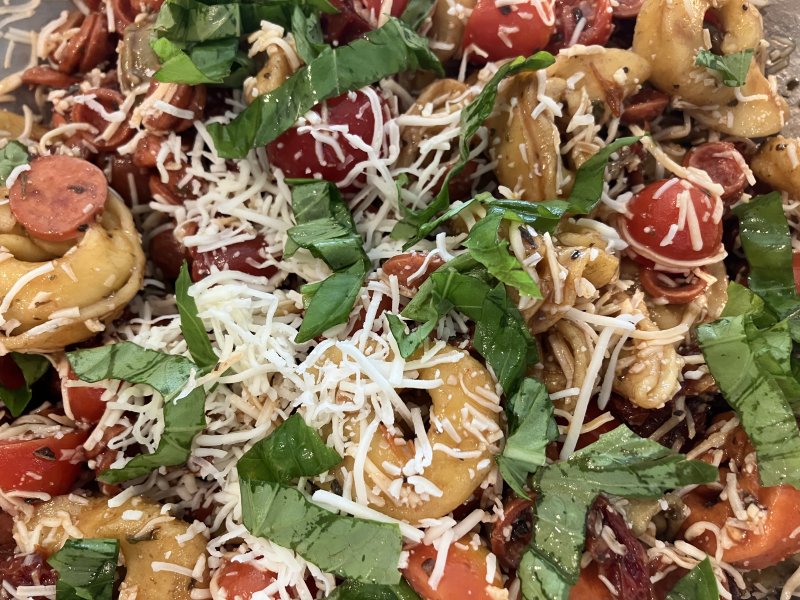Pasta salad offers variety for quick summer side dishes
This time of year you will encounter all sorts of pasta salads, the ideal dish for warm weather. Pasta salads are a mixture of cooked pasta, cheese, vegetables and seasonings combined with a vinegar- or mayonnaise-based dressing. My earliest encounter with them was in the grammar school cafeteria, where they served slippery elbow macaroni in a sweet white sauce dotted with chopped pickle relish.
Food historians trace the roots of pasta salad to Mediterranean cuisine, where ancient Romans served cold pasta with oil and vinegar. Most notably, the Sicilian region of Italy is mentioned, where pasta fredda has been served for centuries. One supposition is that the dish was invented by Italian Jews, who were prohibited from cooking on the Sabbath and so reserved sufficient cooked pasta to have a filling meal for the family.
The recipe for pasta fredda calls for pasta, mozzarella pearls (bocconcini), olives, herbs, and olive oil. The choice of pasta is usually a short one (not spaghetti or linguini) that has ridges or curled edges designed to trap the olive oil and seasonings. This is a dish where you might consider using bronze-cut pasta, a type that is made by extruding pasta dough through perforated bronze plates.
The use of bronze dies gives the pasta a rougher, more porous texture, which allows it to more effectively absorb the sauce or dressing, providing a boost to both flavor and texture. Many commercial pasta companies, such as De Cecco, now offer bronze-cut versions of the familiar shapes, which were originally found only in specialty shops.
To evaluate the performance of bronze-cut pasta, the folks at “America’s Test Kitchen” compared two different versions: De Cecco and Ronzoni. The first uses true bronze dies, while Ronzoni uses a teflon-coated die to make the production process speedier and less expensive. After the pasta was boiled in blue-dyed water, the images from the test clearly show the way DeCecco collected more color, while Ronzoni shed the dyed water.
In the final step of this experiment, they used sandpaper on a rotary sander to rough up the surface of the Ronzoni pasta. The close-up photos showed how the sanding had changed the texture. After boiling in the colored water, the pasta’s color fell between the authentic bronze-cut version and the smoother teflon-processed version. I’m definitely not endorsing using a sander on your pasta, but do suggest trying a good bronze-die-cut pasta to experience the difference.
Back to pasta salad: After the less-than-wonderful macaroni salad of my youth, I came to enjoy cold spaghetti as an emergency breakfast during my lean college years and well into young adulthood. Then, when I started cooking in earnest, I tried several versions of more sophisticated pasta salads, including a version of the one in the photo. This calls for cheese tortellini instead of plain pasta, which increases the protein in the dish.
This particular recipe was adapted from The Washington Post, where Becky Krystal modified the simple dressing by including some of the liquid from the bottle of oil-packed, sun-dried tomatoes. She also added fat that was rendered from sautéing the pepperoni, but I skipped that step, since I felt like there was plenty of oil. Fresh basil is the perfect garnish, and your harvest of cherry tomatoes will shine in this dish.
Pasta Freddo
Cook the pasta in a large pot filled with boiling salted water until al dente. Drain it in a colander and return to the same pot. Immediately add the olive oil and toss to coat. Add halved cherry tomatoes, olives, roasted red peppers and mozzarella pearls. Add grated garlic and basil. Mix thoroughly; cover and refrigerate for at least 3 hours. Season to taste with salt and pepper to serve. Yield: 6 servings.
Tortellini Pasta Salad*
Cook the tortellini according to package directions in well-salted water. While pasta cooks, start making the dressing by placing the olive oil in a glass measuring cup. Pour off 2 T oil from sun-dried tomatoes and add to the measuring cup. Roughly chop the sun-dried tomatoes and place in a large serving bowl. Add halved cherry tomatoes and mozzarella pearls to the serving bowl. Sauté the pepperoni until slightly crisp, about 3 minutes; drain and add to the bowl. Drain the pasta and add to the bowl; toss to combine. Finish the dressing by whisking vinegar and seasoning into measuring cup. Pour over the pasta and toss again. Cover and refrigerate for at least 2 hours. To serve, season to taste with salt and pepper; garnish with shredded Parmesan and basil. Yield: 6 servings.
*Adapted from The Washington Post.






















































